Outside the Walls
When the University
of Michigan opened its
enormous Lurie bell tower,
the gift of a benefactor, on its North Campus
in Ann Arbor in 1996, some students
said they were displeased that the 167-foot-high
tower had no clock. The benefactor
had stipulated a bell, not a clock, but the
young people didn’t leave it at that. Some
creatively rebellious students rigged up a
laser to project a blinking 12:00 onto the
side of the tower, conjuring the image of an
unprogrammed readout on a digital clock.
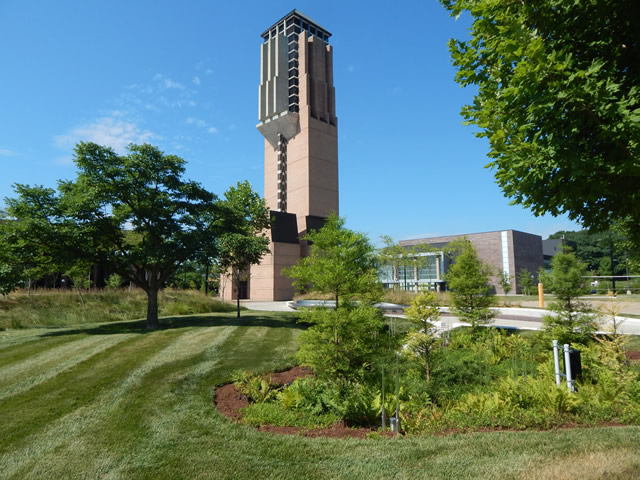
PHOTO © SCOTT BERMAN
There still is no clock on the tower,
and it is a constant that some people will
use outdoor spaces and the exteriors of
buildings in ways unintended by designers.
However, the site surrounding the tower has
changed much since then. In fact, the green
quad of the North Campus—the campus
is where the university’s engineering, arts,
and architecture programs reside—underwent
a major transformation, completed in
2016, which turned an underutilized space
into a varied outdoor set of landscape and
hardscape renamed the Eda U. Gerstacker
Grove. Three years later, a visit showed a
distinctive, naturally evolving place.
Something Different at the University of Michigan
As indicated by the university’s John
Keedy, facilities director for Engineering
on North Campus who related the story
about the blinking light on the tower,
the desire was for an outdoor space that
“would attract more people.” Even though
the university’s nearby Nichols Arboretum
and the central campus Diag are signature
outdoor features of the institution and
of Ann Arbor, the call this time was for
“something unique and different” at North
Campus.
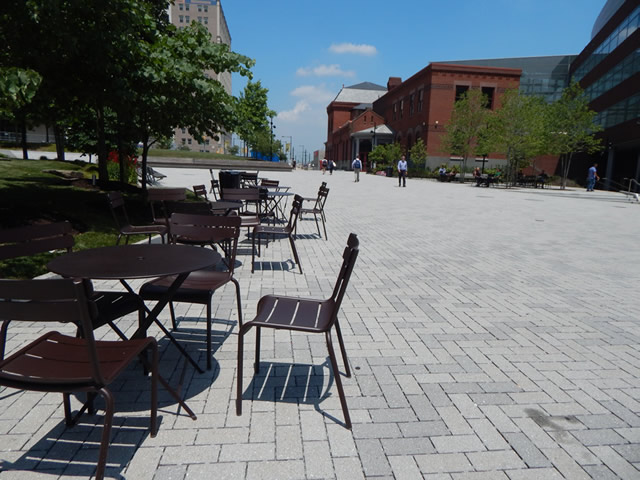
PHOTO © SCOTT BERMAN
Stoss, the Boston design firm, has described
the Grove in part as “a lush and active
space that can accommodate a range of
rotating performances, events, and everyday
activities. It was conceived as a flexible
green quad, with clearings in an elegant
grove that can host larger-scale activities.”
The firm indicates that the plaza paving
is “an expressive feature” that creates “a
truly unique look and feel.” The walkways
at the Grove curve gently through grassy
mounds, trees, and stormwater infiltration
gardens, and are punctuated by raised,
rounded curbs and metal benches. Small
LED lights add various colors to the illumination
of the grounds. It is all arrayed
around the clock tower.
Integrating attractive hardscape with
green areas, as well as situating inviting outdoor
furniture—fostering a range of uses,
such as individual or group study or dining—indicates the desire of an institution to
create and equip excellent spaces. Additionally,
lesser-used spots can be turned into attractive
outdoor places, bringing in a variety
of students whether or not their majors are
housed directly nearby, and bringing new
life to the spot, as was a driving force for the
Grove at Michigan.
Integrating the
Surrounding Community
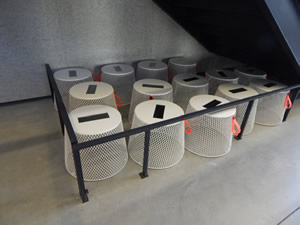
PHOTO © SCOTT BERMAN
There are many ways to make a significant
difference. Outdoor locales can be
bold, in a sense, by turning the campus or
adjoining city streets—or parking lots—into promenades or plazas, such as at University
of Texas-Austin, Sheridan College
in Wyoming, Mercer University in Macon,
GA, and Drexel University in Philadelphia.
To take one, Drexel’s Perelman Plaza, on
the site of a former city street, installed
metal furniture and long, welcoming
wooden benches keyed to landscaping.
On the other hand, adding something
of modest scale can be an integral part of a
wider process of creating an attractive outdoor
place. The right signage and bollards
can help define spaces and routes through
them with logic, for example. There is the
idea that good routes can be found by initially
leaving some areas unpaved—until
foot traffic wears paths, sometimes called
“desire paths,” into the ground, thus identifying
potential routes for pavement.
In some creative moves encountered in
recent years:
- Haverford College in Pennsylvania has
metal stools, equipped with solar cells,
which can be brought outside to provide
seating and light for events that take
place or last after sunset.
- Chatham University’s Eden Hall campus
in Gibsonia, PA, uses an attractive
canopy tent at its amphitheatre and has
an environmentally friendly sewageprocessing
unit that appears to be a wine
barrel—there are wineries in the region.
- Phoenix College in Arizona has brought
native vegetation right to the curtain wall
near the covered entrance of its Hannelly
Center, adding life to the hardscape.
Unintended Uses
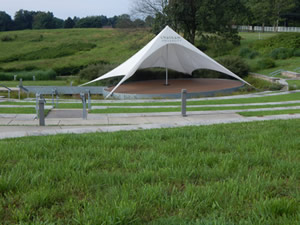
PHOTO © SCOTT BERMAN
On another tack, playful yet strategic
touches can go a long way toward further
establishing informal activities in a defined
space, such as a durable outdoor ping-pong
table amid walkways, as at Cornell Tech’s
recently opened Roosevelt Island campus
in New York City.
The features and forms of the Michigan’s
North Campus Grove, like those on so many
other outdoor spaces on campuses, have
also drawn, as indicated earlier, unintended
uses; in this instance skateboarding on
curbs and benches. This activity has left
some minor damage, but on the positive side
indicates that the space is an attraction.
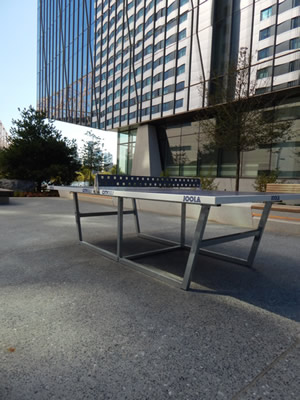
PHOTO © SCOTT BERMAN
As Keedy explains, and Stoss has indicated,
casual play, even though of a different
nature, was a part of equation as well.
When planners were preparing the Grove,
Keedy reports that students in focus groups
suggested at least two related features:
sand volleyball courts and a swing set. The
swing set initially may have seemed to be
a strange request to officials. But as the
young people put it, “‘We work with our
minds all day; we want some brainless activity.
We could just swing,’” Keedy relates.
The swing set—its swings are mounted on
springs—was added, and has proven to be
a popular feature of the Grove.
Whatever the form and feature, one
marker of a successful outdoor space on
a campus is its usage, even if some uses
are unanticipated. And such uses, like the
space itself, change. Over time, attractive
structures amid vibrant vegetation and
stately trees, all in a space animated by
plenty of programmed and unprogrammed
activities, will provide continuing relevance,
beauty, fond memories among
alumni, and sense of place.
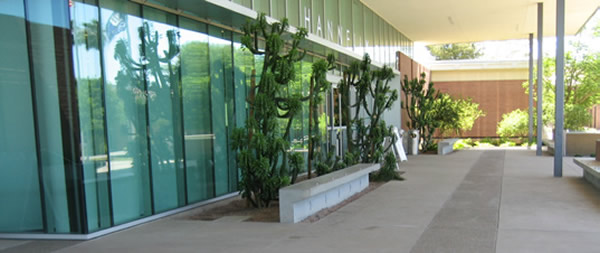
PHOTO © SCOTT BERMAN
SOME IDEAS ABOUT
OUTDOOR FEATURES AND PROJECTS
- Make a statement. In other words,
express with outdoor projects what your
institution is about and where it is heading.
Such projects take vision and careful,
collaborative planning.
- Take a holistic approach. Work with the
experts on- and off-campus to consider all
the factors, ranging from daylight hours
during the months when most students
are on campus, because it may affect the
amount of usage and lighting, to the use of
salt on walkways and roads in or abutting
landscapes, which may help guide the selection
of plants and trees.
- Weigh the pros and cons of one-off or
standard features. Selecting excellent,
distinctive custom-made elements may be
worth it, even if normal wear and tear make
them difficult to replace in the future. However,
off-the-shelf, standard components
may be an alternative.
- Create landscapes with trees and
plants that will look grander in years
and decades to come. The day that a
major outdoor project is completed should
not necessarily mark its best appearance.
This article originally appeared in the College Planning & Management October 2019 issue of Spaces4Learning.